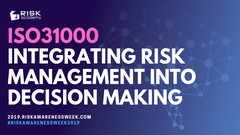Наши популярные онлайн курсы
This special one day event is dedicated to improving risk awareness and raising money for charities supporting the victims of the war in Ukraine. We are very grateful to the amazing speakers who decided to share practical case studies on integrating risk management into decision making and quantitative risk analysis. All workshops are free to watch. Remember to donate to the charity of your choice.
Free registration https://charity.riskawarenessweek.com/
You can watch the workshops live on 28 April or watch replays at the later stage when convenient. You can watch on your laptop, tablet or phone.
Help children and families displaced by the crisis in Ukraine through World Vision International. Scan the QR code on the left or visit https://www.wvi.org/emergencies/ukraine/donate-now, view the due diligence on the charity https://www.charitynavigator.org/ein/951922279 to donate with confidence.
Check out the full agenda:
Future trends in Risk Management 2.0 (50 minutes)
Welcome to the special RISK AWERENESS charity event 2022. Alex will introduce the speakers, explain the structure of the event and share some exiting news about the risk awareness week. Alex will then talk about 4 important trends in risk management 2 and how we can use risk management as a powerful decision making tool.
ChanceCalc: The lightbulb for your probability power grid (30 mins)
Just as electrification replaces technologies that use fossil fuels with those that use electricity, Chancification replaces computations based on deterministic numbers with those based on probability distributions. Just as non-experts can illuminate light bulbs with electricity generated by power engineers, Chancification will allow everyday managers (even those suffering from Post-Traumatic Statistics Disorder, or PTSD) to illuminate uncertainty and fix the Flaw of Averages with stochastic libraries created by statisticians and data scientists. Sam will demonstrate free tools that will help you jump start this process within your own organization.
How to measure risk manager’s performance (60 mins)
Join David Vose, Graeme Keith and Alex Sidorenko to talk about risk management value and how organisations can quantitatively measure positive effect from risk management. The speakers will share ideas and metrics that organisations can use to measure the effectiveness from their risk management departments. Risk managers will also find this valuable to improve their communication with shareholders and top managers.
Effective risk reporting (40 mins)
Risk management processes are deployed in many different ways between companies. They all have to report to Management and the Board. Common for many of these reports is that focus on reporting on risks. However, executives and board members are not really they interested in risks – but are (and should be) focused on performance. Effective risk reporting is NOT a matter of reporting on risks. In this session Hans Læssøe will demonstrate and discuss how risks, levers and uncertainties can be embedded in performance metrics and pave the way to a risk adjusted performance reporting. Hans will even be using red/amber/green color coding – but will keep focus where it belongs, that is, on performance. The approach can be used on individual decisions/project, strategies, budgets, investment portfolios and overall company performance alike. This is very useful as it will allow each manager to see different levels of reporting using the same approach and hence “keep the eye on the ball”.
Quantifying reputational risk (72 mins)
For many companies and from the frontlines to the boardroom, reputational risk is of the greatest importance. For example, it can impact brand, sales, share price, employee attraction and many other things. While most companies are using a matrix approach to evaluate them, what are the alternatives? In this workshop, we will take a look at a few options that can be brought in to better evaluate and manage this risk, using open-source software.
The specter of resilience (45 mins)
“Organizational Resilience” seems like the answer now. But businesses are throwing their money away, chasing after anything that ‘feels’ right. As there is no common or researched understanding of just what it means to be a resilient organization, we all resort to a scattershot approach. In this odd and entertaining presentation, Dr. Lindstedt will begin to uncover what we often wrongly think constitutes resilience, and sets us on the right path to building resilient organizations.
Chancification: How to fix the flaw of averages (25 mins)
Chancification: How to Fix the Flaw of Averages, available on Kindle and soon to be released in paperback, describes new technologies and data standards to solve the problems of dealing with uncertainty exposed by my earlier book, The Flaw of Averages: Why We Underestimate Risk in the Face of Uncertainty (John Wiley & Sons, 2009, 2012). John Wiley & Sons has generously offered a 30% discount on the paperback edition of The Flaw of Averages. Go to this link and use the discount code BPFS2 (be sure to click Apply).
Bringing quantification into the game – how to manage risks more efficiently
Why ordinal scales and heat maps are used for operational risk. Why scores and heat maps can lead to false conclusions. How to test the level of error introduced by heat maps. Using bowtie risk diagrams to better describe key risks and their treatment. How quantitative bowtie diagrams better reflect the intentions of Basel II’s AMA approach. How to include of non-financial risks. How to optimize the cost effectiveness of risk treatments. Incorporating sequential risks in a bowtie network.
Check out other decision making books
RISK-ACADEMY offers online courses

+ Buy now
Informed Risk Taking
Learn 15 practical steps on integrating risk management into decision making, business processes, organizational culture and other activities!
19,999,99

+ Buy now
ISO31000 Integrating Risk Management
Alex Sidorenko, known for his risk management blog http://www.riskacademy.blog, has created a 25-step program to integrate risk management into decision making, core business processes and the overall culture of the organization.
199,999,99

+ Buy now
Управление рисками
В этом коротком и очень увлекательном курсе, Алексей Сидоренко расскажет о причинах внедрения риск менеджмента, об особенностях принятия управленческих решений в ситуации неопределенности и изменениях в новом стандарте ИСО 31000:2018.
19,999,99


































